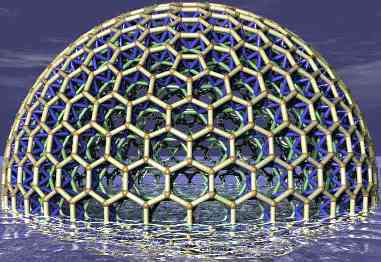
HexDome
Hexagonal Geodesic Domes - Isometric Struts
Using struts of equal length
After reading my "dimpled domes" essay,
Dick Fischbeck directed me to Joe Clinton's
[Equal Central Angle Conjecture] -
which suggests that it is possible to construct
hexagon-based domes using struts of precisely equal
length in the hexagonal layer.
While this essay doesn't contain a proof of the hypothesis -
or even much concrete evidence favouring it - it
does contain some suggestive drawings - which
illustrate that it's possible to at least get pretty close
to struts having equal lengths in hexagon-based domes.
From the perspective of building domes, this is probably
good enough: the question of whether you need a few
odd-length struts sometimes - if you want the dome
to avoid all deviations from the surface of the sphere - can
be largely left to future theoreticians.
This leads to the question of whether using equal-length
struts in domes is desirable:
Advantages
- Fewer resources spent on cutting strut material - sometimes;
- Less wasted strut material;
- Avoidance of the issue of long struts being more prone to buckling;
- Struts can more easily be recycled in subsequent structures;
- The resulting panels may be of more uniform area;
- Structural strength is more evenly distributed over the dome's surface.
Disadvantages
- Panes covering the surface are less flat - possibly a problem if glazing is being used;
- Hubs become more variable - possibly increasing
hub costs;
- Forces in struts become more variable - possibly
increasing the required strength of the strut material;
- Existing works on dome buliding are not quite so
relevant to the new structures.
Hub types
Whether there are cost savings associated with using hubs of equal length
depends to some extent on the type of hub used to connect them.


If the hubs are of the first type, the struts may not need much cutting.
However the second type of hub makes using a mitre saw much
more desirable - and if you have to saw the ends of the
struts anyway, using struts of the same length
doesn't save you as much effort.
On balance
I'm not sure the distortions present in an icosohedral dome
are large enough to be too concerned about - so the
practical differences in strength in the resulting domes are
probably fairly minor.
The other issue with using isometric struts is the fact that
the panels deviate from all being in the same plane more
than they do with a conventional structure. If you are
using a flexible covering, this may not be an issue - but if
you have plans to cover the dome with something rigid - such
as glass - then these deviations from the plane may well be
a problem.
Tim Tyler |
Contact |
http://hexdome.com/
|